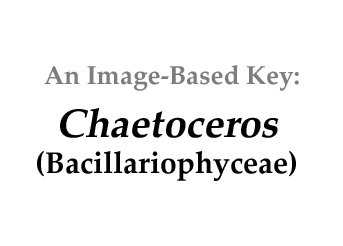|
Home / Diatoms / Centric / Filaments / Chaetoceros |
||||
|
|
||||
|
Click on images for larger format |
||||
Name derivation: |
||||
|
From the Greek chaite, long hair, and keras, horn. Latin meaning prickly, spinelike. |
||||
Classification: |
||||
|
Chaetoceros Ehrenberg 1844; 198 of 501 species descriptions are currently accepted taxonomically (Guiry and Guiry 2013). Order Chaetocerotales; Family Chaetocerotaceae |
||||
Morphology: |
||||
|
In valve view the frustules (cell walls) are circular or elliptical. At the end of each cell there are two symmetrical spike-like horns that curve outward. In girdle view, the two horns are much longer than the cell and grow outward from each other. The horns can be solid, hollow, smooth or ornamented with punctae or spines. The cells can be joined in straight or spirally twisted chains because of the way the horns interlock to hold the cells together. The cell walls have no intercalary bands. The number and size of chromatophores differ from species to species. The formation of an auxospore occurs when two half cells separate and the protoplast is excreted in a vesicle. The protoplast then develops into a single auxospore. |
||||
Similar genera: |
||||
|
Attheya is similar in appearance with the exception that its frustules have several intercalary bands. |
||||
Habitat: |
||||
|
Mostly marine species and can be found in brackish waters with the exception of C. Elmorie in Devils Lake, North Dakota. |
||||
References: |
||||
|
Graham L. and Wilcox L. . Algae. Prentice-Hall. (2000) Guiry. M.D. and G.M. Guiry 2013. AlgaeBase. World-wide electronic publication, National University of Ireland, Galway. http://www.algaebase.org; searched on 21 Dec 2013. Hasle, G. et al. Identifying Marine Phytoplankton. Academic Press. (1997).
|
||||












